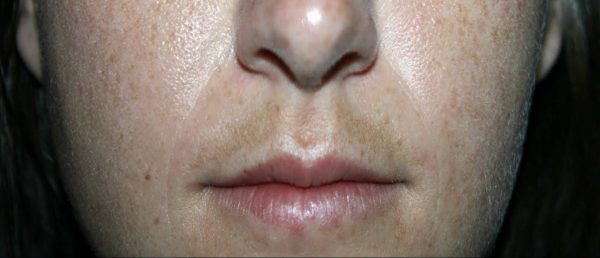You may have arrived here looking for treatment for facial blemishes. You may already be aware that this is not an easy task. What you may not be so clear about is that the term “blemish” encompasses different dermatological conditions and that each of them requires a specific and differentiated treatment. Not all blemishes are treated in the same way. Moreover, treatments that benefit one type of blemish may even worsen another type.
So let’s get to the point: what types of spots are the most common? In general, when we start to worry about spots in our thirties or forties, they can be divided into two main groups.
SOLAR LENTIGO
What are solar lentigos?
They are flat spots, reminiscent of freckles, although they are usually larger. They appear in areas where we have been exposed to the sun. This exposure does not necessarily have to be the previous summer, but they are caused by all the sun accumulated throughout our lives. That is to say, you may have been taking care of the sun for decades, but if in adolescence you did something excessive, this may be the cause of these lentigines. The skin has a memory.
How to treat solar lentigos?
Lentigines respond very well to physical treatments such as laser or pulsed light. These systems work by emitting a light source that reacts with the color of the blemish. The darker the spot and the lighter the underlying skin, the more likely it is that the treatment will be successful, which is why it is especially interesting to perform the treatment at times when we are paler, as is often the case in winter.

In the following 4 weeks it is equally important to avoid the sun as much as possible. Sun exposure on “inflamed” skin after laser treatment could cause another type of stains called post-inflammatory hyperpigmentation, which is not at all desirable.
The treatment causes some changes in the spots that will last a few days/weeks: in the case of laser it can be a purplish tone or crusts and in the case of pulsed light, the spots take on a grayish color. Then they will progressively fade until they disappear.
MELASMA:
What is melasma?
Also called chloasma, they are more diffuse spots that usually cover the area of the cheeks, forehead or upper lip, usually appearing in women. Generally lighter than lentigines but larger in size. They are usually related to having gone through a pregnancy or taking contraceptives, although many women suffer from them without any of these factors. In this link I talk more about melasma.

How to treat melasma?
In general, melasma is more complex to treat than lentigines. Contrary to what one might think, physical techniques in this case do not work as well and are generally relegated to the background.
The initial approach to melasma should always include rigorous sun protection, preferably with colored products (either a tinted sunscreen or using makeup over it) to block the effect of visible light (which influences the appearance of melasma).
Specific treatment is done with depigmenting creams, which almost always include hydroquinone. This can be supplemented with retinoids or other depigmenting agents (kojic, niacinamide, tranexamic, azelaic), as well as peelings.
In recent years, moreover, scientific evidence has shown the effectiveness of an oral treatment that helps us to complement topical therapy with creams: tranexamic acid, which you can read about in this article.
Melasma reappears very frequently, so it is very important to maintain strict sun protection habits at all times (both summer and winter).
